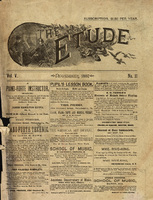THE ROSE. By Anton Strelezki. H. B. Stevens, Agent, Boston, Mass.
Good song, with simple but attractive melody and easy accompaniment. Will go with “Dreams” and ”Wooing,” by the same author. Highest note “F#.”
LOVE’S SUNSHINE. LOVE’S CONFIDENCE. By Jules Jordan. H. B. Stevens, Agent, Boston, Mass.
Two songs for soprano or tenor, refined and fresh in melody and setting. The carefully-prepared accompaniments assist, by well-chosen rhythmic and melodic designs, in the appropriate expression of the text. Highest note in either song “G.”
FOR THEE. By Alfred G. Robyn. H. B. Stevens, Agent, Boston, Mass.
Good, easy song for middle voice without striking features. Words from one of Kjerulf’s songs.
VALSE FANTASTIQUE. Op. 1., No. 1. By Walter E. Hall. H. B. Stevens, Agent, Boston, Mass. For a “first appearance,” this piece has points of excellence to commend it. The repetitions of the two leading subjects are so done as to secure variety and interest, although the frequent variations in tempo seem unnecessary. The closing three bars in first subject, in G minor, and its repetition on third page, contain an ill-sounding progression. Two good transition subjects appear. After an effective variation of second subject in dominant key, quick time, the piece closes with first subject in G major. Good fingering and generally good phrasing. Bad misprints occur at foot of second page. All the above are tastefully gotten up on good paper with clear type. C. P. H.
ELEMENTS OF MODERN OCTAVE PLAYING FOR PIANO-FORTE. Op. 28. By A. D. Turner. New England Conservatory of Music, Boston, Mass.
There has ever been a want in all of the many systems of octave playing published from time to time of melody and more simple and direct methods in the preparatory work that this volume from the talented pen of A. D. Turner seems to supply. While the rudimentary work is carefully thought out and systematized, there is no lack of melody and interest in the etudes, all carefully graded, fingered and with copious annotations. Kullak and many modern masters have been drawn on but sparingly, and the book seems to fill a place preparatory to Kullak and the Chopin and Liszt etudes, where so much difficult wrist work is expected, and where, as a rule, the bewildered pupil is lauded after a few tentative studies and expected to have his forearm and wrist in good working order. Here all is carefully planned and every sort of octave playing is illustrated—legato and staccato and mixed, skips and interlocked passages (now so essential in modern piano playing) can be found. There are some very pretty and tuneful studies that could be utilized for actual performances, and, altogether, the whole work is well worth studying for practical benefit to pupils, and being full of ideas for teachers. It can be procured from us on order. J. H.
SYSTEM OF TECHNIC. By A. Spengler. Price, $1.50. Theo. Presser, Philadelphia. This work, by one of our leading teachers, embodies all that has been recently developed in piano technic. There are numerous passages in the works of modern piano-forte composers that call for a different technic than that required when Plaidy’s technic was made. When this new work does not lose sight of the old, it recognizes what is new.



